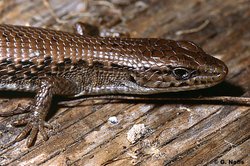Northern Alligator Lizard
|
|
| Northern Alligator Lizard | ||||||||||||||
|---|---|---|---|---|---|---|---|---|---|---|---|---|---|---|
 | ||||||||||||||
| Scientific classification | ||||||||||||||
| ||||||||||||||
| Binomial name | ||||||||||||||
| Elgaria coerulea (Wiegmann, 1828) |
The Northern Alligator Lizard (Elgaria coerulea) is a medium-sized lizard that occurs on the North American west coast.
| Contents |
Taxonomy
This lizard has been formerly been known under the scientific name of Gerrhonotus coeruleus (Wiegmann, 1828), but is nowadays classed as Elgaria coerulea. There are four subspecies:
- E.c. coerulea Wiegmann 1828: San Francisco Alligator Lizard
- E.c. palmeri Stejneger 1893: Sierra Alligator Lizard
- E.c. principis Baird and Girard 1852: Northwestern Alligator Lizard
- E.c. shastensis Fitch 1934: Shasta Alligator Lizard
The subspecies E.c. principis is one of five species of lizards in Canada.
Description
Northern Alligator Lizards are medium-sized slender lizards. Adults reach a snout-to-vent length of about 10 cm (4 inches) and a total length of roughly 25 cm (10 in). They have a distinct skin fold on their sides, separating the keeled scales on the back from the smooth ventral scales. They are brownish in color and often have dark blotches that sometimes blend together into bands. The belly is light gray. The eyes are dark.
Habits
The Northern Alligator Lizard feeds on a wide variety of small invertebrates such as insects, spiders, millipedes, or snails. It prefers a more humid environment than the Southern Alligator Lizard.
The species is viviparous, i.e. the female gives birth to living young. The mating season is in spring (April - May). In late summer, between three and eight young are born in a single litter. Sexual maturity is reached after about three years.
Range and habitat
The Northern Alligator Lizard occurs along the Pacific Coast and in the Rocky Mountains from southern British Columbia in Canada through Washington, northern Idaho and western Montana south through Oregon until the coastal range and the Sierra Nevada in central California. As the map shows, the different subspecies have quite different ranges, with E.c. principis being the most widely distributed, whereas the E.c. coerulea subspecies occurs only north and south the San Francisco area.
The species is widely distributed along the Pacific coast and can be found from sea level up to elevation of about 3350 m (11000 ft). It is found in a variety of forested habitats and montane chaparral.
External links
- Images from Californiaherps.com (http://www.californiaherps.com/lizards/lizards.html)
- Description (http://www.dfg.ca.gov/whdab/html/R042.html) from the California Department of Fish and Game.
- Taxonomical Information (http://www.itis.usda.gov/servlet/SingleRpt/SingleRpt?search_topic=TSN&search_value=209008)
